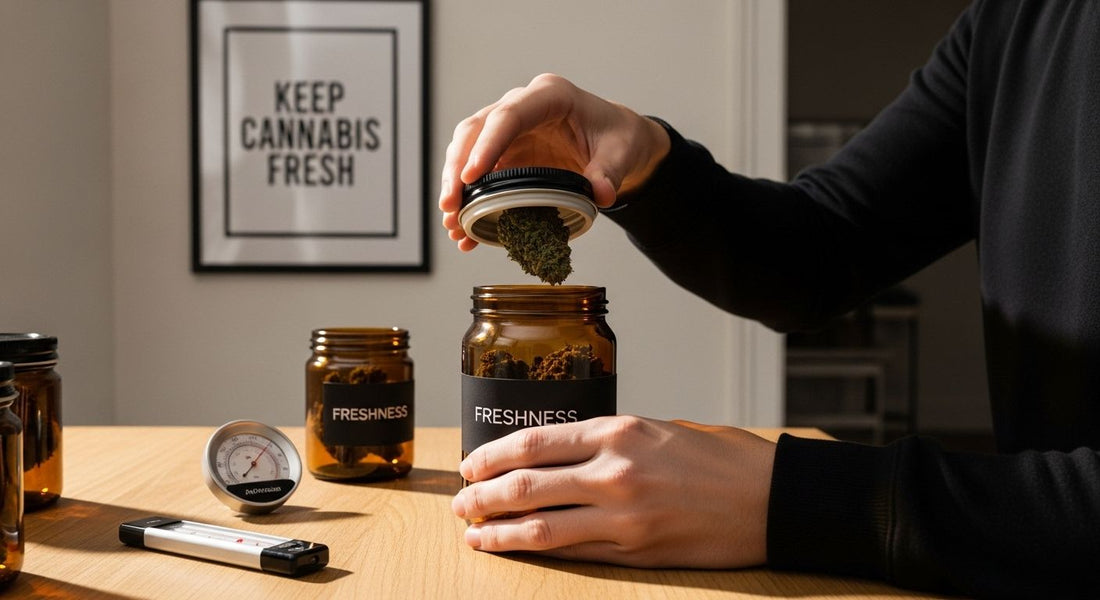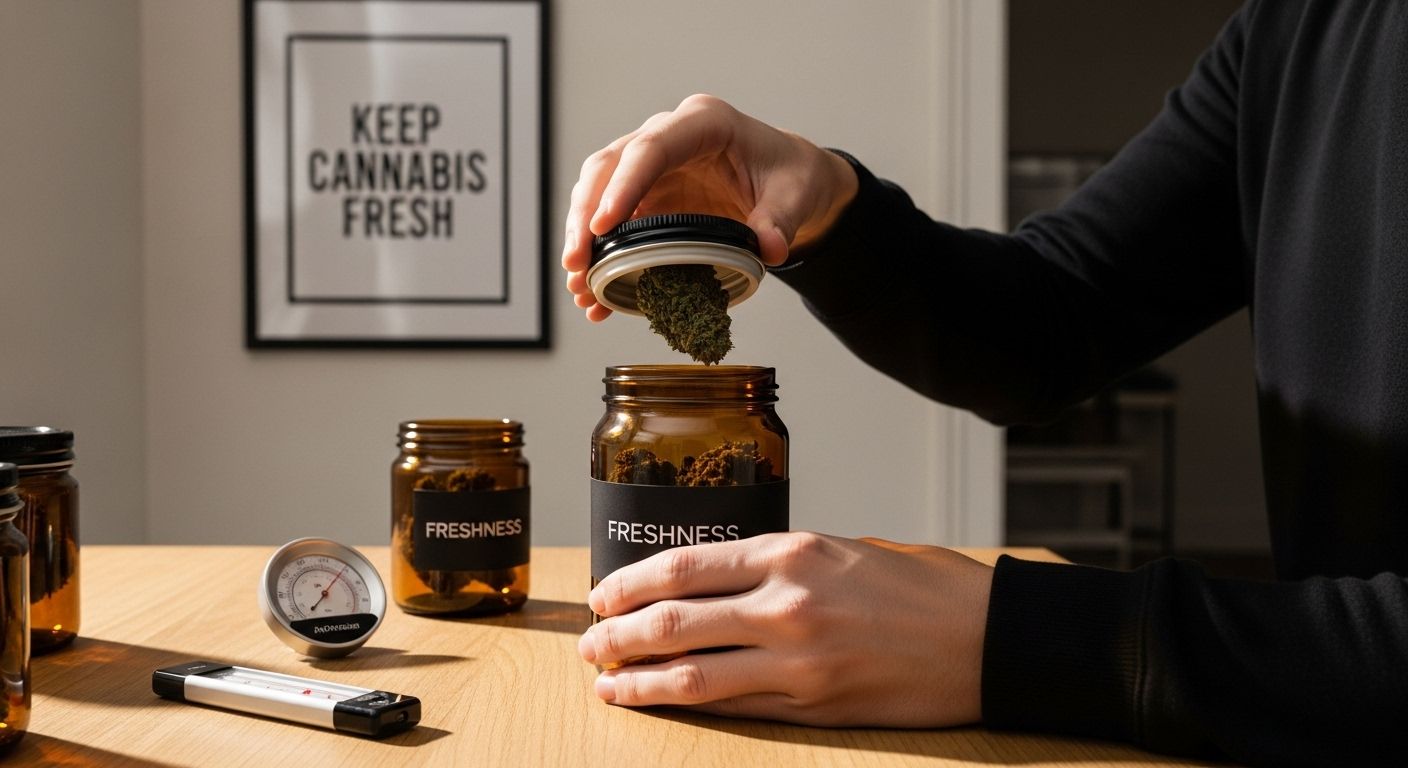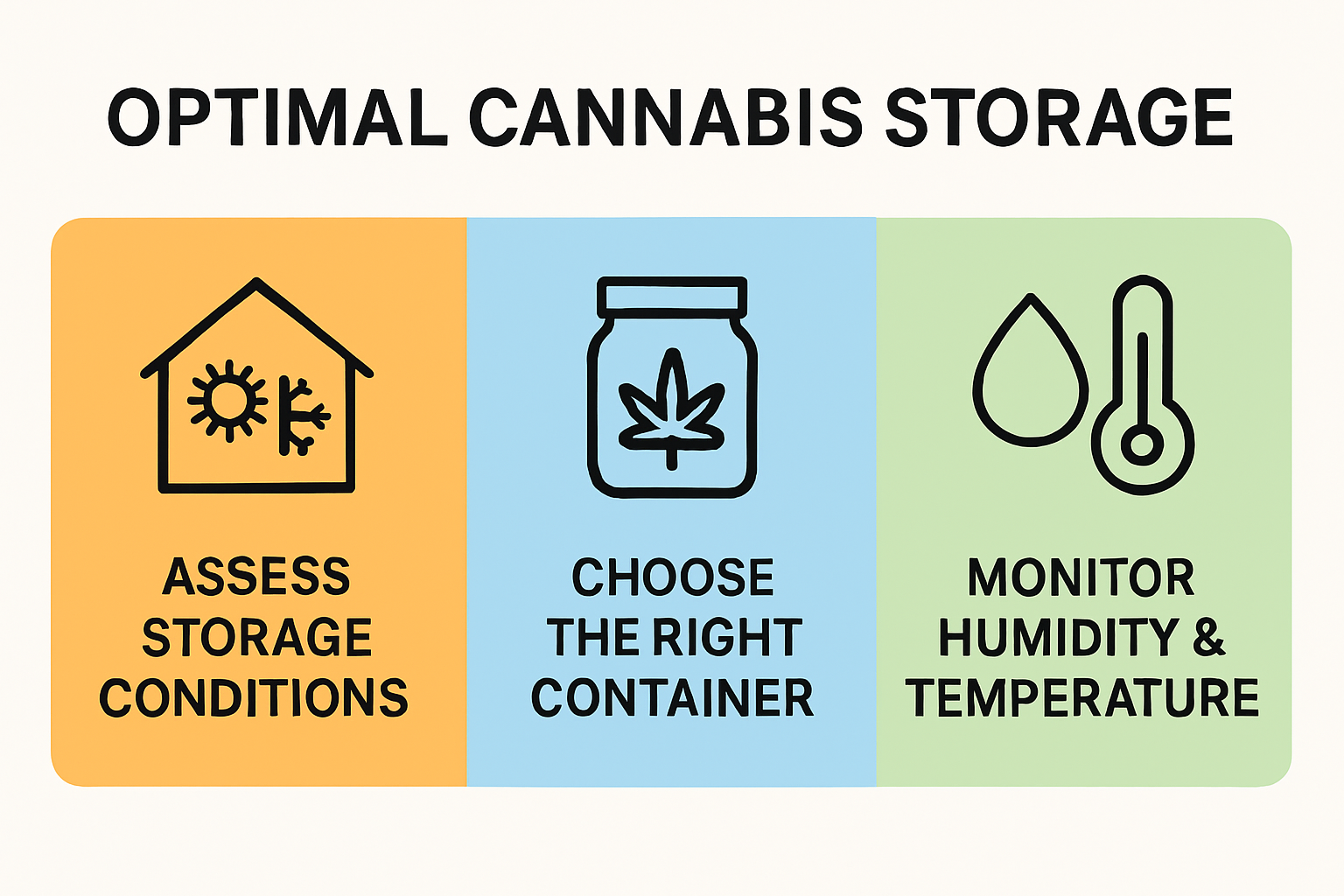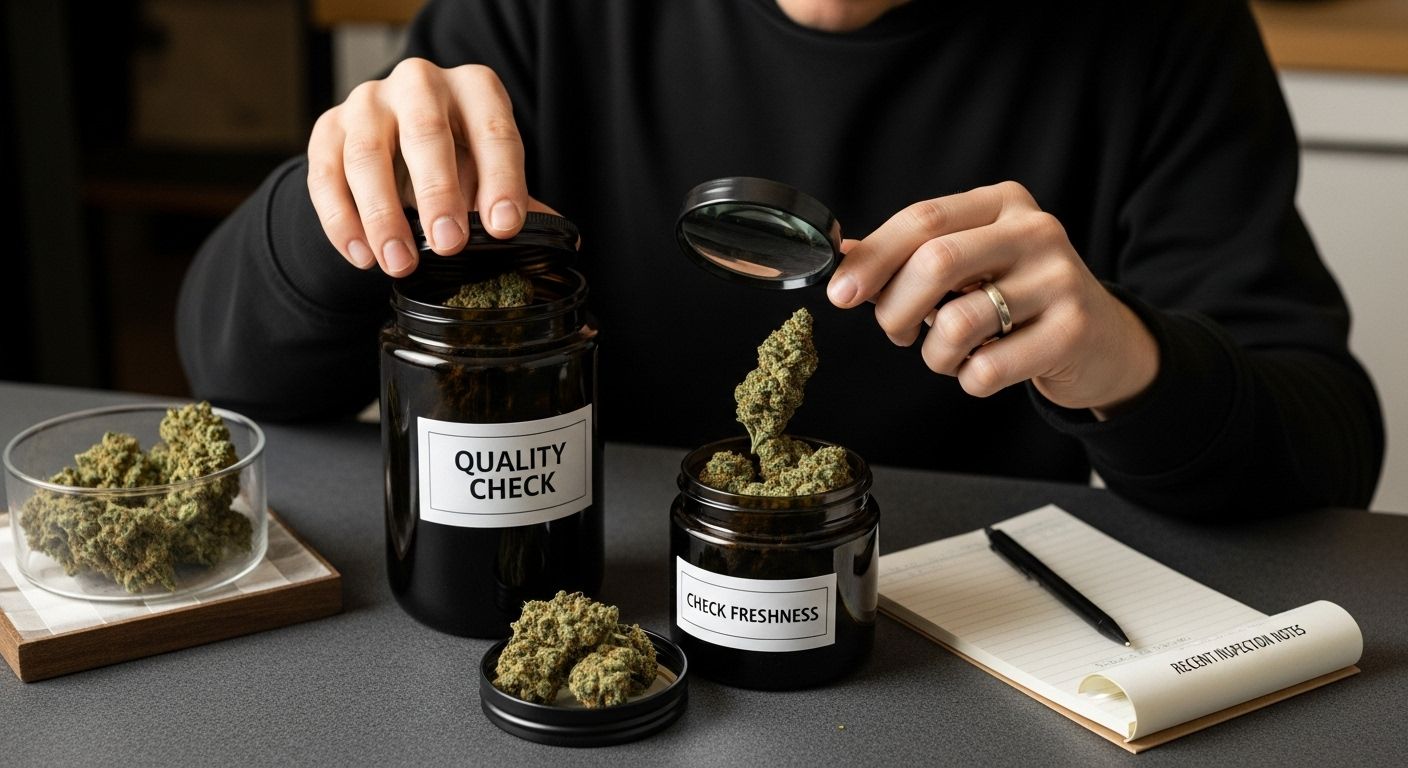How to Keep Cannabis Fresh: A Practical Guide for 2025
Written by California Blendz

Most cannabis users do not realize that the way they store their stash could be quietly ruining its strength and flavor.

Shockingly, improper storage can cause noticeable potency loss and rapid terpene breakdown, with up to 40 percent of quality vanishing in a few months. The usual methods people rely on, like plastic bags or sunny windowsills, might actually speed up the decline instead of preserving freshness.
Table of Contents
- Step 1: Assess Your Current Storage Conditions
- Step 2: Choose The Right Storage Containers
- Step 3: Control Humidity And Temperature Levels
- Step 4: Seal And Label Your Cannabis Properly
- Step 5: Regularly Check For Freshness And Quality
- Step 6: Adjust Storage Practices As Needed
Quick Summary
| Key Point | Explanation |
|---|---|
| 1. Assess your storage conditions carefully | Evaluate temperature, humidity, and light exposure affecting cannabis quality. Adjust accordingly to preserve potency and flavor. |
| 2. Choose airtight glass containers | Use high-quality glass jars with airtight seals to protect against light, air, and moisture that can degrade cannabis. |
| 3. Maintain optimal humidity levels | Keep relative humidity between 59% and 63% to avoid mold or brittleness, using hygrometers for accurate measurement. |
| 4. Seal and label containers properly | Ensure airtight seals and label with strain details and storage dates to track potency and prevent confusion. |
| 5. Regularly check cannabis quality | Inspect appearance, smell, and texture monthly to ensure freshness and detect any early signs of degradation. |
Step 1: Assess Your Current Storage Conditions
Storing cannabis effectively starts with a thorough evaluation of your current storage environment. Most people unknowingly compromise their cannabis quality through improper storage practices, which can rapidly degrade potency, flavor, and overall experience. Your initial goal is to understand the existing conditions that might be compromising your cannabis and develop a strategic approach to preservation.
Begin by examining your current storage location critically. Temperature, humidity, light exposure, and air circulation are the primary factors that determine cannabis freshness. Walk through your storage area and note any potential issues: Are your cannabis products currently stored near heat sources like radiators, sunny windows, or kitchen appliances? Direct sunlight and excessive heat can accelerate cannabinoid degradation and destroy delicate terpene profiles.
Humidity presents another critical challenge in cannabis storage. Environments with moisture levels above 65% create significant risks of mold and mildew growth, while environments below 55% can cause cannabis to become brittle and lose its essential oils. Use a hygrometer to measure precise humidity levels in your storage area. If you discover significant fluctuations or extreme conditions, it signals an immediate need for specialized storage solutions.
Learn more about optimal cannabis preservation techniques that can help you maintain product quality. Your assessment should also consider container type and seal quality. Transparent containers or plastic bags expose cannabis to light and potential contamination, whereas airtight, opaque glass containers with tight seals provide superior protection.
Successful storage assessment means identifying and eliminating environmental factors that compromise cannabis quality. By understanding your current storage conditions, you’re laying the groundwork for maintaining potency, flavor, and overall product integrity.
Step 2: Choose the Right Storage Containers
Selecting the ideal storage container is a critical step in preserving your cannabis quality and potency. The wrong container can rapidly degrade your product, destroying its flavor, effectiveness, and overall experience. Your goal is to find a solution that protects against light, air, moisture, and temperature fluctuations while maintaining the delicate chemical composition of your cannabis.
Glass containers with airtight seals emerge as the gold standard for cannabis storage. Unlike plastic containers that can leach chemicals or impart unwanted flavors, high-quality borosilicate glass provides an inert, non-reactive environment. Mason jars with rubber gasket seals offer excellent protection, creating a microclimate that shields your cannabis from external degradation factors. Size matters too - choose containers that minimize excess air space, which can accelerate oxidation and cannabinoid breakdown.
Here is a handy reference table summarizing the key tools and materials needed for effective cannabis storage, along with their purposes and important notes.
| Tool/Material | Purpose | Notes |
|---|---|---|
| Airtight glass container | Protects cannabis from air and light | Preferred: Borosilicate glass with gasket seals |
| Opaque/dark container | Blocks UV light | Amber or cobalt blue glass, or ceramic suggested |
| Hygrometer | Monitors humidity levels | Essential for ensuring optimal 59%-63% RH |
| Humidity control packs | Stabilizes moisture in the container | Prevents mold or dryness |
| Vacuum sealer | Removes oxygen for long-term storage | Advanced option, excellent for bulk preservation |
| Waterproof labels | Organizes and keeps strain info | Use fade-resistant labels and permanent markers |
| Mini-refrigerator | Maintains consistent cool temperature | Optional; avoid general fridges with excess moisture |
Explore advanced cannabis storage techniques that go beyond basic preservation. When evaluating containers, look for these critical features: UV protection, airtight seals, and opacity. Dark amber or cobalt blue glass containers provide additional light protection, blocking harmful UV rays that can degrade cannabinoids and terpenes. Ceramic containers with tight-fitting lids also offer excellent storage properties, combining light blocking with temperature stability.
Your verification process should include a simple test: place your cannabis in the new container, seal it completely, and store it in a consistent environment. Check the container weekly for any signs of moisture buildup, seal integrity, and product condition. A high-quality storage container will maintain your cannabis texture, prevent crumbling, and preserve its aromatic profile, ensuring you experience the full potential of your product.

Step 3: Control Humidity and Temperature Levels
Controlling humidity and temperature represents the most critical factor in maintaining cannabis quality and preventing degradation. Your storage environment directly impacts the potency, flavor, and overall therapeutic potential of your cannabis. Think of your cannabis like a delicate botanical specimen that requires precise environmental conditions to preserve its intrinsic properties.
Temperature management is your first line of defense. Ideal storage temperatures range between 596F and 776F, with consistent coolness being far more important than achieving an exact number. Avoid storing cannabis in areas with temperature fluctuations like kitchen counters, near heating vents, or windowsills. Basements and interior closets often provide the most stable temperature environments. Consider investing in a small, dedicated mini-refrigerator for long-term storage, which can maintain consistent cool temperatures without introducing moisture.
Discover advanced preservation techniques that professionals use to maintain product quality. Humidity control requires equally meticulous attention. According to scientific research, the optimal relative humidity range sits between 59% and 63%. Invest in a quality hygrometer to monitor these levels precisely. Too much moisture creates mold risks, while too little humidity causes cannabis to become brittle and lose its essential oils. Humidity control packs or small silica gel packets can help stabilize moisture levels within your storage containers, acting as a buffer against environmental changes.
Verification is straightforward: regularly check your stored cannabis for signs of moisture, mold, or texture changes. Properly stored cannabis should maintain its original color, aroma, and structural integrity. If you notice any discoloration, musty odors, or unusual texture changes, it signals that your current storage conditions need immediate adjustment.
Step 4: Seal and Label Your Cannabis Properly
Proper sealing and labeling are not just organizational steps but crucial preservation techniques that protect your cannabis investment. Incorrect sealing can expose your product to degrading environmental factors, while inadequate labeling can lead to confusion and potential misuse. Your goal is to create a comprehensive storage system that maintains product integrity and provides clear, useful information.
Sealing requires absolute precision. Once you have selected your ideal storage container, ensure the seal is completely airtight. Vacuum sealing represents an advanced technique for long-term storage, removing oxygen that can accelerate cannabinoid degradation. For those using traditional containers, press the lid firmly, creating a vacuum seal that minimizes air exposure. Pay special attention to rubber gaskets and container rim alignment - even small gaps can compromise your cannabis quality.
Explore comprehensive cannabis storage solutions that professionals recommend. Labeling is more than just adding a name. Create a detailed label that includes strain name, purchase date, cannabinoid percentage, and storage date. This information helps track potency degradation and ensures you consume cannabis at its peak effectiveness. Use waterproof, fade-resistant labels and consider using a permanent marker for additional durability. Include storage recommendations specific to that particular strain, as different cannabis varieties might have nuanced preservation requirements.
Verification involves a weekly inspection process. Check your sealed containers for any signs of moisture buildup, seal integrity, and label legibility. A well-sealed and labeled cannabis storage system should maintain product color, aroma, and structural composition. If you notice any condensation, label peeling, or seal compromise, immediately transfer your cannabis to a new, properly sealed container to prevent quality loss.
Step 5: Regularly Check for Freshness and Quality
Regular quality checks are the final defense in preserving your cannabis investment, transforming storage from a passive to an active preservation strategy. Cannabis is a living botanical product that continues changing even after harvesting, requiring consistent monitoring to maintain its therapeutic potential and sensory characteristics. Your goal is to develop a systematic approach that allows you to detect subtle changes before they compromise your product.
Visual and sensory inspection forms the cornerstone of your quality assessment. Examine your cannabis under natural light, looking for consistent color, intact trichome structure, and absence of discoloration or mold. Healthy cannabis should maintain a vibrant green to deep green coloration with visible crystal-like trichomes. Gently smell the product each time you inspect it - a fresh, aromatic cannabis should release a complex bouquet of terpenes. Any musty, hay-like, or overly fermented odors indicate potential degradation. Be gentle during these inspections to avoid damaging delicate trichomes that carry the plant’s essential compounds.
Discover expert techniques for cannabis preservation that professionals use to maintain product integrity. Texture assessment is equally critical. Cannabis should feel slightly springy when gently squeezed, not brittle or excessively dry. If the product crumbles easily or feels like dust, it has likely lost significant moisture and cannabinoid potency. Consider maintaining a simple log to track each inspection, noting date, observed characteristics, and any changes. This documentation helps you understand your specific storage environment’s impact and adjust your preservation techniques accordingly.
To help you quickly review and perform essential quality checks, use this monthly cannabis storage checklist. It covers key inspection points to verify freshness and identify any potential issues early.
| Quality Check | What to Look For | Action if Issue Detected |
|---|---|---|
| Color | Vibrant to deep green, no discoloration | Move to better storage or discard |
| Aroma | Fresh, aromatic, complex bouquet | If musty or hay-like, review storage |
| Trichome structure | Visible crystal-like coating, intact | Avoid handling if trichomes appear dull |
| Texture | Slightly springy, not brittle or dusty | Add humidity control if excessively dry |
| Mold/Contaminants | No visible white powdery patches, no off smells | Discard immediately if mold detected |
| Container seal integrity | No condensation, fully airtight seal | Replace container if seal is compromised |
| Label legibility | Strain/name, date, readable and durable | Re-label with new waterproof label |
Verification involves a comprehensive monthly review. Check for signs of mold (white powdery patches), detect any significant potency loss, and ensure your storage containers remain intact. A successful quality maintenance strategy will preserve your cannabis’s original color, aroma, and structural composition, guaranteeing a premium experience with each use.

Step 6: Adjust Storage Practices as Needed
Storage adaptation is the final critical skill in maintaining cannabis quality, transforming your preservation approach from static to dynamic. Cannabis is a complex botanical product that responds differently to various environmental conditions, requiring a flexible and responsive storage strategy. Your goal is to develop an intuitive understanding of how your specific cannabis strain interacts with its storage environment.
Environmental monitoring becomes your primary tool for strategic adjustments. Temperature fluctuations, humidity shifts, and light exposure can dramatically impact cannabinoid composition and terpene profiles. Invest in a digital hygrometer and thermometer to track precise storage conditions, creating a baseline for understanding your cannabis’s unique preservation requirements. Pay special attention to seasonal changes that might affect your storage area’s temperature and humidity. A storage location that works perfectly during winter might become problematic during humid summer months, necessitating creative solutions like moving containers to cooler, more stable areas or introducing additional humidity control mechanisms.
Learn advanced cannabis preservation strategies that professionals use to maintain product integrity. Different cannabis strains and product types may require nuanced storage approaches. Sativa-dominant strains might be more sensitive to temperature variations, while indica varieties could have different moisture retention characteristics. Develop a flexible mindset that allows you to experiment with storage techniques. Consider creating a simple tracking log that documents storage conditions, product characteristics, and any observed changes. This documentation transforms your storage practice from guesswork into a scientifically informed process.
Verification involves quarterly comprehensive reviews of your storage practices. Assess whether your current methods maintain the cannabis’s color, aroma, potency, and structural integrity. Successful adaptation means your storage strategy evolves alongside your understanding, ensuring optimal preservation of your cannabis product’s unique qualities.
Ready to Keep Your Cannabis Fresh and Potent?
You’ve just learned how vital proper storage is for preserving your cannabis quality. Losing freshness means losing not just flavor, but also the therapeutic benefits and enjoyment you seek. Imagine seeing differences in aroma, potency, and texture simply because your storage solutions fell short. If you want your investment in premium cannabis to last, the right choice of top-tier flower and smart storage techniques is essential. Explore the expertly curated options in the THCa Flower Collection where each batch is grown, harvested, and handled with preservation in mind.

Make an immediate difference by choosing products that are organically grown, lab-tested, and sourced for quality you can trust. Don’t risk letting your cannabis degrade. Browse California Blendz now and find both the exclusive strains and the educational support you need. Commit to your best 2025 cannabis experience today and enjoy your favorite strains at their peak while supplies last.
Frequently Asked Questions
How should I assess my current cannabis storage conditions?
To assess your cannabis storage, evaluate factors like temperature, humidity, light exposure, and air circulation. Look for heat sources and direct sunlight, which can degrade potency and flavor. A hygrometer can help measure humidity levels accurately.
What is the best type of container for storing cannabis?
The best containers for storing cannabis are airtight, opaque glass containers. High-quality borosilicate glass jars with tight seals prevent exposure to light and air, helping maintain freshness. Avoid plastic containers as they may leach chemicals and affect flavor.
How can I control humidity and temperature in cannabis storage?
Maintain temperatures between 59°F and 77°F and keep humidity levels between 59% and 63%. Use a dedicated mini-refrigerator or stable closets for storage, and humidity control packs to manage moisture levels within containers, preventing both mold and brittleness.
Why is proper sealing and labeling important for cannabis storage?
Proper sealing protects your cannabis from air and moisture exposure that can lead to degradation. Accurate labeling helps track strain information, purchase and storage dates, ensuring you consume the product at its peak potency. Vacuum sealing can enhance long-term storage effectiveness.
Recommended
- How to Store Cannabis Flower for Freshness in 2025 – California Blendz
- How Long Are Pre-Rolls Good For? Storage Tips to Keep Them Fresh – California Blendz
- Are Mylar Bags a Good Choice for Storing Cannabis Flower? A Comprehens – California Blendz
- How to Store CBD Flower Properly – California Blendz
- How to Keep a Basil Plant Alive - Lushy Gardens
- The Essential Guide to Safely Storing and Handling Meat, Poultry, and Seafood - Probe IT








